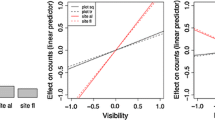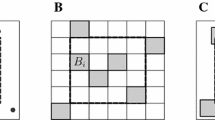Abstract
In estimating the number of species per quadrat with a given area, we usually need much time and labor, because we have no simple ways to easily count it using hardware. We devised here a software method to estimate the mean number of species by counting them only partially in the survey, and estimating it mathematically. We classify quadrats into three classes composed of k, k + 1 and more than k + 1 species; or classify quadrats into four classes composed of k, k + 1, k + 2, and more than k + 2 (referred to as “censored sampling”), where k is the minimum number of species per quadrat. We do not need to count more than k + 2 or k + 3 species, respectively. Using only these 3 or 4 numerals we can estimate the mean of number of species per quadrat, the 95% confidence intervals for the mean and know the spatial pattern value such as aggregated, random or uniform pattern of the number of species per quadrat. Using this method, 10–20% time and labor in counting will be saved compared to the full census. The estimates are obtained through the maximum likelihood calculation. Computer programs to estimate the mean number of species per quadrat are attached as ESMs.




Similar content being viewed by others
References
Bonham DC (2013) Measurements for terrestrial vegetation, 2nd edn. Blackwell-Wiley, New York
Chen J, Shiyomi M (2014) Spatial pattern model of herbaceous plant mass as species level. Ecol Inform 24:124–131. https://doi.org/10.1016/j.ecoinf.2014.08.001
Chen J, Shiyomi M, Yamamura Y, Hori Y (2006) Distribution model and spatial variation of cover in grassland vegetation. Grassl Sci 52:167–173. https://doi.org/10.1111/j.1744-697X.2006.00065.x
Chen J, Okumura K, Takada H (2008a) Estimation of clover biomass and percentage in a performance trial of white clover-timothy binary mixtures: use of multiple regression equations incorporating plant cover measured with the grid-point plate. Grassl Sci 56:127–133. https://doi.org/10.1111/j.1744-697X.2010.00184.x
Chen J, Yamamura Y, Hori Y, Shiyomi M, Yasuda T, Zhou H-K, Li Y-N, Tang Y-H (2008b) Small-scale species richness and its spatial variation in an alpine meadow on the Qinghai-Tibet Plateau. Ecol Res 23:657–663. https://doi.org/10.1007/s11284-007-0423-7
Chen J, Shiyomi M, Bonham CD, Yasuda T, Hori Y, Yamamura Y (2008c) Plant cover estimation based on the beta distribution in grassland vegetation. Ecol Res 23:813–819. https://doi.org/10.1007/s11284-007-0443-3
Chen J, Shiyomi M, Hori Y, Yamamura Y (2008d) Frequency distribution models for spatial patterns of vegetation abundance. Ecol Model 211:403–410. https://doi.org/10.1016/j.ecolmodel.2007.09.017
Chen J, Gaborčík N, Shiyomi M (2016) A probability distribution model of small-scale species richness in plant communities. Ecol Inform 33:101–108. https://doi.org/10.1016/j.ecoinf.2016.04.003
Chytrý M, Dražil T, Hájek M et al (2015) The most species-rich plant communities in the Czech Republic and Slovakia (with new world records). Preslia 87:217–278
David F, Moore PG (1954) Notes on contagious distributions in plant populations. Ann Bot 18:47–53. https://doi.org/10.1093/oxfordjournals.aob.a083381
Gould W (2000) Remote sensing of vegetation, plant species richness and regional biodiversity hotspots. Ecol Appl 10:1861–1870. https://doi.org/10.2307/2641244
Katharina A, Engelhardt M, Kadlec JA (2001) Species traits, species richness and the resilience of wetlands after disturbance. J Aquat Plant Manag 39:36–39
Lavorel S (1999) Ecological diversity and resilience of Mediterranean vegetation to disturbance. Divers Distrib 5:3–13. https://doi.org/10.1046/j.1472-4642.1999.00033.x
Nicholas J, Gotelli NJ, Colwell RK (2011) Estimating species richness. In: Magurran AE, MacGill BJ (eds) Frontiers in measurement and assessment. Oxford University Press, Oxford
Oliver TH, Heard MS, Isaac NJB et al (2015) Biodiversity and resilience of ecosystem functions. Trends Ecol Evol 30:673–684. https://doi.org/10.1016/j.tree.2015.08.009
Pallett DW, Pescott OL, Schäfer SM (2016) Changes in plant species richness and productivity in response to decreased nitrogen inputs in grassland in southern England. Ecol Indic 68:73–81. https://doi.org/10.1016/j.ecolind.2015.12.024
Pielou EC (1977) Mathematical ecology. Wiley, New York
Shibayama M (2001) Estimation of leaf area and leaf inclination distributions of perennial ryegrass, tall fescue, and white clover canopies using an electromagnetic 3-D digitizer. Grassl Sci 47:303–306
Shibayama M (2003) Prediction of ratio of legumes in a mixed seeding pasture by polarized reflected light. Grassl Sci 49:229–237
Shibayama M, Akita S (2002) A portable spectropolarimeter for field crop canopies: distinguishing species and cultivars of fully developed canopies by polarized light. Plant Prod Sci 5:311–319. https://doi.org/10.1626/pps.5.311
Shiyomi M (1974) A method for estimating the number of individuals on the assumption of a Poisson or negative binomial distribution. Jpn J Appl Stat 18:106–114 (in Japanese with English summary)
Shiyomi M (1977) A graphic method of quick estimation of animal population density using a censored sample. Appl Entomol Zool 12:18–26. https://doi.org/10.1303/aez.12.18
Shiyomi M (1978) A rapid graphic estimation of density by a qusi-sequential method. Bull Natl Inst Agric Sci Ser A 25:33–57
Shiyomi M (1991) Method for the estimation of herbaceous biomass in grazed pasture by visual observation. Jpn J Grassl Sci 37:231–239
Shiyomi M (1992) Maximum likelihood estimation of herbaceous biomass using data obtained by visual observation in grazing pasture. Jpn J Grassl Sci 38:36–43
Tilman D, Reich PB, Knops J, Wedin D, Mielke T, Lehman C (2001) Diversity and productivity in a long-term grassland experiment. Science 294:843–845. https://doi.org/10.1126/science.1060391
van der Maarel E, Noest V, Palmer MW (1995) Variation in species richness on small grassland quadrats: niche structure or small-scale plant mobility? J Veg Sci 6:741–752. https://doi.org/10.2307/3236445
Yasuda T (2018) Semi-natural grassland vegetation mapping utilizing unmanned aerial vehicles and image analysis. Jpn J Grassl Sci (in press) (in Japanese)
Zobel M, Otsus M, Liina J, Moora M, Mőls T (2000) Is small-scale species richness limited by seed availability or micro-site availability? Ecology 81:3274–3282. https://doi.org/10.1890/0012-9658(2000)081[3274:ISSSRL]2.0.CO;2
Author information
Authors and Affiliations
Corresponding author
Electronic supplementary material
Below is the link to the electronic supplementary material.
About this article
Cite this article
Chen, J., Shiyomi, M. & Bai, H. A timesaving estimation of per-quadrat species number in grassland communities based on a Poisson-like model. Ecol Res 33, 427–434 (2018). https://doi.org/10.1007/s11284-017-1544-2
Received:
Accepted:
Published:
Issue Date:
DOI: https://doi.org/10.1007/s11284-017-1544-2




